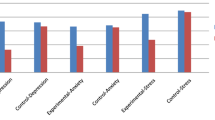Abstract
This study examined the efficacy of muscle relaxation training via electromyographic (EMG) biofeedback from the frontalis and forearm extensor muscles of schizophrenic inpatients. Thirty chronically hospitalized patients were randomly assigned to one of three conditions: EMG biofeedback from the forearm extensor and frontalis muscles, progressive relaxation, and a control group. Treatment consisted of one session of orientation and baseline, and six sessions of training. The results indicated that the schizophrenic patients receiving EMG training had significantly lower EMG recordings than the progressive relaxation group, which, in turn, was significantly lower than the control group. Analyses of covariance on the Tension-Anxiety scale from the Profile of Mood States revealed no significant effects, while finger-tapping rates were significantly improved only for the arm receiving feedback training in the EMG group. On the Nurses Observation Scale for Inpatient Evaluation the biofeedback group significantly improved on the Social Competence and Social Interest factors.
Similar content being viewed by others
References
Acosta, F., Yamamoto, J., & Wilcox, S. (1978). Application of electromyographic feedback to the relaxation of schizophrenic, neurotic and tension headache patients.Journal of Consulting and Clinical Psychology, 46 383–384.
Adler, C. S., & Morrissey-Adler, S. (1983). Strategies in general psychiatry. In J. Basmajian (Ed.),Biofeedback principles and practice for clinicians. Baltimore: Williams and Wilkins.
Bandura, A. (1986).Social foundations of thought and action. Englewood Cliffs, NJ: Prentice-Hall.
Budzynski, T. (1973). EMG biofeedback and tension headaches: A controlled outcome study.Seminars in Psychiatry, 5 397–410.
Calhoun, J. F., & Acocella, J. R. (1983).Psychology of adjustment and human relationships. New York: Random House.
Canter, A., Kondo, C. Y., & Knott, J. R. (1975). A comparison of EMG feedback and progressive muscle relaxation in anxiety neurosis.British Journal of Psychiatry, 127 470–477.
Crayton, J. W., Stalberg, E. E., & Hilton-Brown, P. (1977). The motor unit in psychotic patients: A single fibre EMG study.Journal of Neurology, Neurosurgery, and Psychiatry, 40 455–463.
Fenz, W., & Velner, J. (1970). Physiological concomitants of behavioral indexes in schizophrenia.Journal of Abnormal Psychology, 75 27–35.
Goldstein, I. (1965). The relationship of muscle tension and automatic activity to psychiatric disorders.Psychosomatic Medicine, 27 39–52.
Haynes, R. A., Mosely, D., & McGowan, W. T. (1975). Relaxation training and biofeedback in the reduction of frontalis muscle tension.Psychophysiology, 12 547–552.
Honigfeld, G., Gillis, R., & Klett, C. (1966). NOSIE-30: A treatment sensitive ward behavior scale.Psychological Reports, 19 180–182.
Keating, C. (1981).Exploration of a combined program of electromyographic biofeedback and progressive relaxation as a treatment approach with schizophrenics. Unpublished doctoral dissertation, Michigan State University, East Lansing.
King, H. (1975a). Psychomotor correlates of behavior disorder. In M. Kietzman, S. Sulton, & J. Zubin (Eds.),Experimental approaches to psychopathology. New York: Academic Press.
King, H. (1975b). Psychomotility: A dimension of behavior disorder. In J. Zubin & C. Shagass (Eds.),Neurobiological aspects of psychopathology. New York: Grune & Stratton.
Kinsman, R. A., O'Banion, K., Robinson, S., & Staudenmayer, H. (1975). Continuous biofeedback and discrete posttrial verbal feedback in frontalis muscle relaxation training.Psychophysiology, 12 30–35.
Malmo, R., Shagass, C., & Smith, A. (1951). Responsiveness in chronic schizophrenia.Psychological Bulletin, 19 359–375.
Manschreck, T. C., Maher, B. A., Rucklos, M. E., & Vereen, D. R. (1982). Disturbed voluntary motor activity in schizophrenic disorder.Psychological Medicine, 12 73–78.
McNair, D. M., Lorr, M., & Droppleman, L. F. (1971).EITS manual for the Profile of Mood States. San Diego: Educational Industrial Testing Service.
Meltzer, H. Y. (1976). Neuromuscular dysfunction in schizophrenia.Schizophrenia Bulletin, 2 106–135.
Meltzer, H. Y., & Crayton, J. W. (1974). Subterminal motor nerve abnormalities in psychotic patients.Nature, 249 373–375.
Newman, P. R., & Newman, B. M. (1981).Living: The process of adjustment. Homewood, IL: Dorsey Press.
Nigl, A., & Jackson, B. (1979). Electromyograph biofeedback as an adjunct to standard psychiatric treatment.Journal of Clinical Psychiatry, 44 433–436.
Pharr, O. M. (1987).The impact of electromyographic biofeedback on the psychomotor functioning and ward behavior of chronic schizophrenic patients. Unpublished doctoral dissertation, University of Maryland, College Park.
Pinto, A., & DeRosa, E. R. (1975).NOSIE-30: An aid to evaluating persons under their care. Crownsville, MD: Crownsville Hospital Center.
Reitan, R. M., & Davison, L. A. (Eds.). (1974).Clinical neuropsychology: Current status and applications. Washington, DC: Winston.
Reynolds, D. J. (1962).An investigation of the somatic response system in chronic schizophrenia. Unpublished doctoral dissertation, University of Pittsburgh.
Schneider, R., & Cauthen, N. (1982). Locus of reaction time change in schizophrenics and normal subjects.Journal of Nervous and Mental Disease, 170 231–240.
Schneider, R., & Grossi, V. (1980). Differences in muscle activity before, during, and after responding in a simple reaction time task: Schizophrenics vs. normals.Psychiatry Research, 7 141–145.
Spaulding, W., Storms, L., Goodrich, V., & Sullivan, M. (1986). Applications of experimental psychopathology in psychiatric rehabilitation.Schizophrenia Bulletin, 12 560–577.
Storms, L., & Broen, W. (1969). A theory of schizophrenic behavioral disorganization.Archives of General Psychiatry, 20 129–144.
Teece, J., & Cole, J. (1972). Psychophysiologic responses of schizophrenics to drugs.Psychopharmacologia, 24 159–200.
Weaver, L., & Brooks, G. (1964). The use of psychomotor tests in predicting the potential of chronic schizophrenics.Journal of Neuropsychiatry, 5 170–180.
Weiner, H. (1979). On altering muscle tension with chronic schizophrenics.Psychological Reports, 44 527–534.
Wentworth-Rohr, I. (1981). Biofeedback for schizophrenia and neurosis.Frontiers of Psychiatry, Roche Report, 11 6–11.
Whatmore, G., & Ellis, R. (1958). Some motor aspects of schizophrenia: An electromyographic study.American Journal of Psychiatry, 114 882–889.
Whatmore, G., & Ellis, R. (1964). Some neurologic aspects of schizophrenia: An electromyographic study.American Journal of Psychiatry, 120 1166–1170.
Author information
Authors and Affiliations
Additional information
We would like to express our appreciation for the contributions the following people made to this project: Drs. Barry Smith, Robert Steele, Agnes Hartfield, Jeffrey Barth, Althea Wagman, and the late Harold Weiner; Earl Downs and the participating staff at Springfield State Hospital Center; and Robert Kline and Michael Kelley, who performed the data analyses. This research was supported in part by a grant from the Computer Science Center at the University of Maryland.
Rights and permissions
About this article
Cite this article
Pharr, O.M., Coursey, R.D. The use and utility of EMG biofeedback with chronic schizophrenic patients. Biofeedback and Self-Regulation 14, 229–245 (1989). https://doi.org/10.1007/BF01000096
Issue Date:
DOI: https://doi.org/10.1007/BF01000096




